Over the years, social media has transformed the world. In the medical community, Instagram is one popular platform on which we can share photos, videos, and aspects of our lives with the public. Also via Instagram, clinicians can share helpful posts related to pathologies that are very informative and contribute to our learning.
Many residency programs recognize the value of creating their own Instagram pages to engage with prospective residents, showcase their program’s unique strengths, and build a sense of community. At Brookdale EM, we have created our own Instagram account (@brookdale_em) that has allowed our program to thrive in these aspects. Through carefully curated content — including educational posts, resident life, and program highlights — these Instagram pages provide an opportunity for programs to establish their brand, share valuable insights, and foster connections with a broad audience.
By utilizing the visual appeal and interactive nature of Instagram, residency programs can offer a glimpse into their program’s culture, values, and education to attract and engage potential residents. Nevertheless, it is crucial to employ this tool in a manner that is appropriate and maintains professionalism. Here, we discuss some pearls and pitfalls of using Instagram to make your EM residency shine.
PEARLS
Recruitment
Every program wants to showcase its strengths and reasons medical students should feel compelled to apply. What are medical students looking for? Some ideas we’ve implemented that have garnered positive feedback from rotating medical students and applicants:
- Instagram Live Q&As. Using Instagram Live, we’ve hosted Q&A sessions featuring our interns, PD/APDs, chief residents, and other residents. We post stories leading up to the event to publicize when the Instagram Live will be hosted. There is a “mark your calendar” feature on Instagram stories that allows viewers to add the event to their phone calendar. There are also “countdowns” that display how many days/hours until the event occurs to remind viewers of the event. We include a “submit question” box so applicants can submit questions ahead of time, but they can also ask during the event by using the text box.
- Story Q&As. These are easier than Instagram Live Q&As because they do not require coordinating time and attendance. Simply provide a question box that allows applicants to submit any questions they have about the program. We had a Q&A session featuring our assistant program director, Alanna O’Connell, DO, and students were able to ask her about anything. A few days later, we posted her answers to their questions using great photos of her with our trauma bay lighting (Photos 1, 2, and 3).
- Life outside the ED. Residents are human beings too! A huge draw for medical students is work/life balance and whether they would be happy at your program. Showcase your extracurricular activities to promote the feeling of wellness, family, and fun. We have received lots of feedback that applicants appreciate seeing our residents having fun together outside of work. Even simple group photos of hangouts at a co-resident’s place or at a restaurant for dinner can show medical students the kind of social energy your program has. (See Photos 4, 5, 6, and 7 for our examples.)
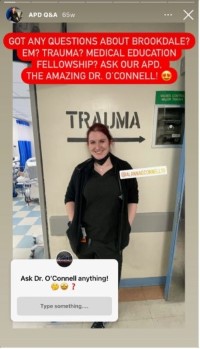
Photo 1
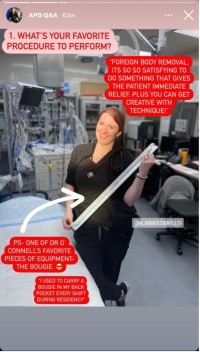
Photo 2
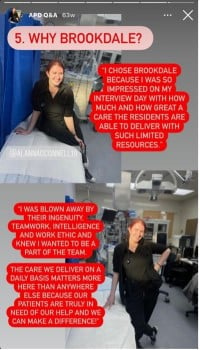
Photo 3

Photo 4

Photo 5
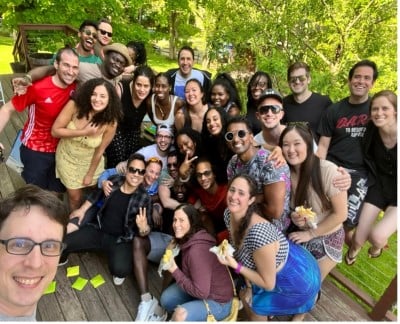
Photo 6

Photo 7
Engagement
The more engaged your followers are, the better your page will do. Some ideas:
- Medical multiple-choice questions. Using imaging from our patients, we give a brief history andpresentation, and ask for the diagnosis. Beware of HIPAA violations: Do not include the patient’s name, date of birth, medical record number, or any other identifying features anywhere on the photo. You can also post the photo a few days or weeks later than when it was taken to eliminate temporal association (e., “My relative is in the ED for the same thing — is this their image?!”). Another option is to completely change the age and date of birth of the presenting patient. For example, if the image is from an 80-year-old male complaining of chest pain, you can change it to a 76-year-old female complaining of shortness of breath. In Photos 8 and 9, both multiple-choice questions were posted at least a few days after each patient presented. We also used a different age than the actual patient to help conceal identity.
- Day-in-the-life posts. Give medical students a sneak-peek into what a day in your ED is like! Dr. O’Connell hosted a “Day in the Life” where she spent a day on our program’s Instagram page posting stories throughout her shift — from the moment she woke up with her morning coffee to her last patient on shift (Photos 10, 11, and 12). Of course, do not post excessively to the point it interferes with your productivity at work. But during downtime, candidly posting stories shows medical students what a workday is like.
- Tags to increase publicity. Tag any other organization or heavily followed Instagram page (examples: Photos 13 and 14, @blackgirlsinhealthcare, @womeninmedicine). They may feature your posts, which could lead to more profile visits and followers. Even for small events like a group lunch or dinner at a specific restaurant, you can tag the restaurant’s Instagram handle for them to repost. It’s a synergistic relationship because they are also getting publicity with your tag — win-win! Another option is to tag the pages of products your program uses, whether it be scrubs, meal prep, supplies, etc. Our residents took a photo in FIGS scrubs,and the company liked it so much that they reposted it on their page. It received thousands of likes, and our page received many followers from this publicity (Photo 15). Our program also loves Hydrant electrolytes and Factor meal prep, and both companies were kind enough to provide donations during the COVID-19 pandemic. We made sure to show them the love on our IG (Photos 16 and 17).
- Spread the love! Engage with other EM programs in the area and their Instagram pages. We love our EM colleagues at Maimonides and NYP-Methodist, and both programs have their own Instagram pages. We have posted photos with them at casual hangouts or at work during outside rotations. You can tag each other and spread the love — and gain followers!

Photo 8

Photo 9

Photo 10

Photo 11
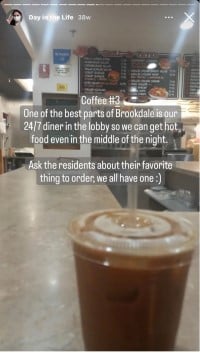
Photo 12
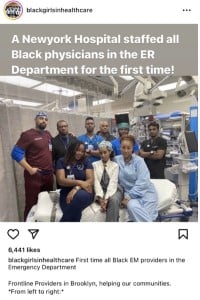
Photo 13
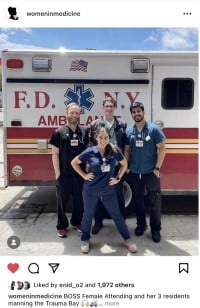
Photo 14
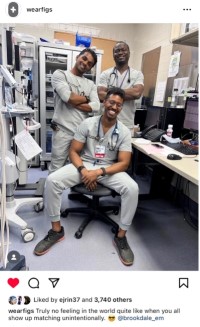
Photo 15
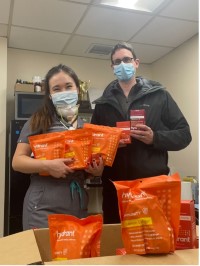
Photo 16
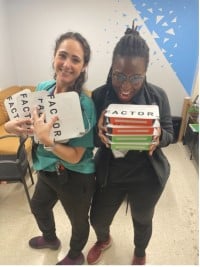
Photo 17
Medical Education
According to a recent survey, almost 98% of emergency medicine residents used social media for learning at least 1 hour a week.1 Instagram has become a valuable platform for medical education. It allows health-care professionals to share informative content such as case studies, medical tips, and educational resources in a visually engaging manner. Through Instagram, medical educators can reach a wide audience including students, residents, and fellow practitioners to foster a sense of community by encouraging discussions and sharing knowledge. Visuals and concise captions on Instagram make it an effective tool for delivering bite-sized medical information, promoting learning, and staying updated with the latest evidence (see examples, Photos 18 and 19).

Photo 18

Photo 19
Photo & Posting Tips
Which photos to take, how to take them, and when to take them are very important to the success of your page. A few tips:
- Let the light shine. In general, a bright light facing your subject makes your photos pop. If your ED is lucky enough to have overhead lighting, use it! It’s an excellent way to simulate professional-quality lighting for your photos. Photos 20 and 21 show this type of light: Our trauma bay has a large overhead light that is turned on, behind the photographer and facing the subjects. This creates perfect lighting for a picture (golden hour can be any hour!).
- Not a graphic designer? There’s help for that. Multiple free or inexpensive tools are available online to help you design your posts. Canva, a graphic design app, is particularly user-friendly. Others include Adobe illustrator, Inkscape, and Pixler. These tools can help you design infographics and other fun posts for your social media site. Photos 22 and 23 show examples of the use of Canva to help create visually appealing posts.
- Timing is everything. When you post seems to influence how many views you get. Post when your audience is most likely to be on social media. If your target is medical students, for example, consider posting in the evenings or during lunchtime to catch them on a social media break. Research has been mixed on whether timing affects the amount of engagement, but logically this makes sense.2 Posting at 2 am while most of the world is asleep will not get as much engagement as posting during peak hours.
- How much is too much? Consistency is key when it comes to posting. One of the best ways to keep your audience engaged is to post regularly. Regular posting gets people in the habit of interacting with your page and keeps them coming back for more content. One way to remember to post is to keep an ongoing calendar notification on your phone or computer reminding you to generate content. On this calendar, you can keep track of consistent days for posting, and you can use the calendar as a map for future content ideas. For example, during recruitment season you can plan out specific resident and faculty spotlights, department tours, and Q&A livestreams. Keep in mind, however, that too much posting may be a turn-off to followers. Posting multiple times a day (excluding stories) may seem like spam to followers, and this could lead to unfollowing (Photo 24).
- Choose ideal backgrounds. A great background truly makes a difference in the quality of a photo. To comply with HIPAA, opt for areas that do not include any patients. Avoid cluttered areas and other staff working in the background. One of the most appealing backgrounds in our ED is our ambulance bay — extra points if an ambulance is in the background. We also love using our trauma bay (especially because of overhead lighting and background supplies) when no patient is in the main bed. Other ideas include empty patient rooms with the bed and monitor in the background, especially the resuscitation beds. Photos 25-30 showcase our favorite backgrounds at Brookdale.
- Feature your US department. At Brookdale, we have a fantastic ultrasound program as well as a fellowship program. Our residents have dedicated ultrasound blocks to perform scans in the ED with our ultrasound faculty, as well as participate in QA sessions weekly. We get great photo content from these rotations and are able to showcase our rotating residents, cool cases/ultrasounds, and fun with the ultrasound faculty. With our ultrasound team, we use the ultrasound machines and like to play around with the probes. You can even go the extra mile and type a fun message pertaining to the photo (e.g., “Ultrasound Team,” as seen in Photos 31 and 32 during an ultrasound rotation with our US fellowship director).
- Color coordinate! Some facilities may have designated scrub colors, but if not, color coordinate with your colleagues. For many of our shifts, we arrive in identical scrub colors coincidentally and decide to take a photo. If you know you’ll be working with a certain co-resident or attending, text them the day before and let them know which colored scrubs to wear. The uniformity of colors is visually appealing (Photos 33-35).
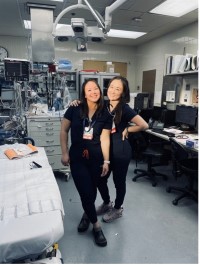
Photo 20
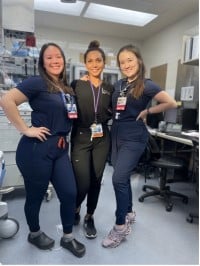
Photo 21

Photo 22
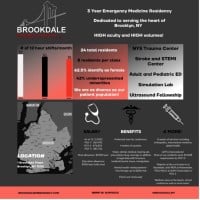
Photo 23
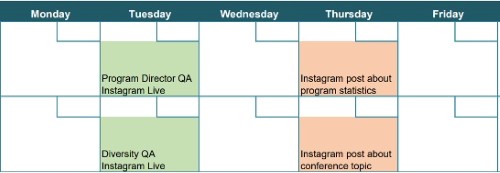
Photo 24

Photo 25
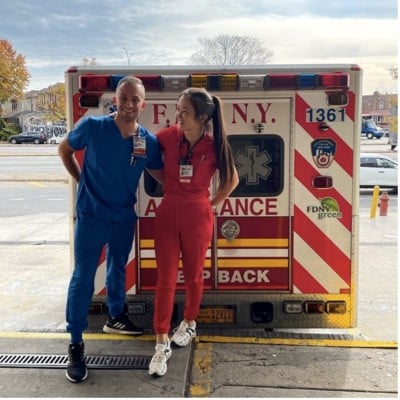
Photo 26

Photo 27
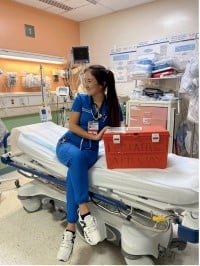
Photo 28
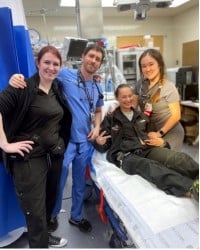
Photo 29
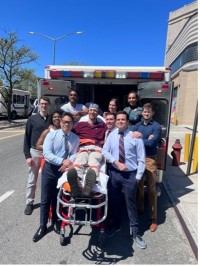
Photo 30
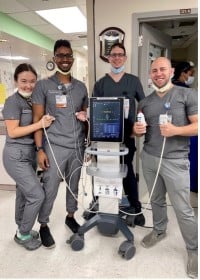
Photo 31
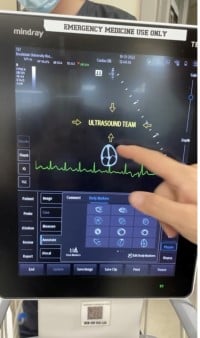
Photo 32
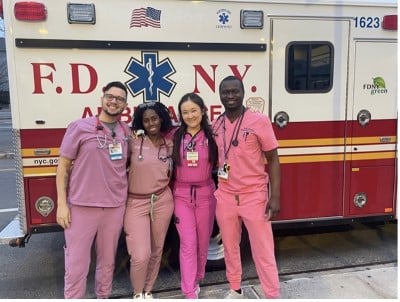
Photo 33
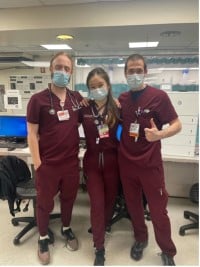
Photo 34
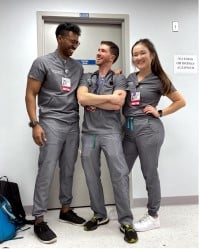
Photo 35
PITFALLS
Although social media is a fun and useful tool, it has its limitations and must be used with caution — especially in the medical field.
Patient Privacy and HIPAA
As physicians, we have learned from day one that patient confidentiality is of utmost importance. This especiallyapplies to social media. The AMA’s Code of Medical Ethics addresses this in Article 2.3.2 Professionalism in the Use of Social Media: Physicians should be cognizant of standards of patient privacy and confidentiality that must be maintained in all environments, including online, and must refrain from posting identifiable patient information online.3Some basic rules to always follow:
- NEVER include history of present illness or any details that reveal a patient’s identity. This includes name, date of birth, medical record number, or any identifying factors (tattoos, specific clothing, skin tone, voice, physical appearance).
- If posting an X-ray or CT image (for example, a multiple-choice question on what caused a specific pathology seen on a chest X-ray), make sure to crop out the patient’s name, DoB, MRN, and even the date the X-ray was taken. ONLY the X-ray image should be shown.
- If posting a procedure, make sure the patient is completely draped and not visible at all. NO identifying characteristics such as tattoos, skin tone, or prominent, unique features (moles, for example) should be visible.
- As mentioned previously, post the photo later (g., the next day) to eliminate temporal association. Followers may know someone in the area who came to the ED with a similar complaint and could associate the photowith them.
It is important to remember that once content is online, it likely remains there permanently, regardless of utilizing strong privacy settings or deleting posts afterwards.3
Photos 36-38 show how to utilize diagnostic tests while adhering to HIPAA rules and preserving patient confidentiality. Always make sure there is no name, MRN, date of birth, or any other identifying information shown!
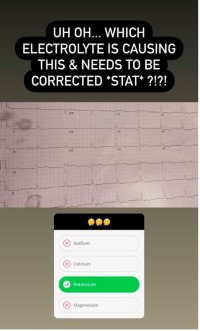
Photo 36

Photo 37
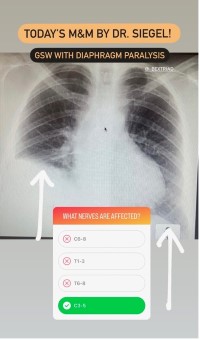
Photo 38
Potentially Unprofessional Posts
Professionalism is of utmost importance, and it is essential to seek approval from your program director and/or core faculty before posting any potentially questionable photos. This includes images featuring drinking or alcohol consumption. Even if everyone in the photo is of legal drinking age, it is important to consider that your followers may have varying perspectives on alcohol. To err on the side of caution, it is advisable to share group photos and engage in activities that do not involve alcohol when showcasing your fun nights out. Unprofessional posts have the potential to significantly impact the image of a residency program. Inappropriate content can erode trust, undermine credibility, and deter prospective applicants who are seeking a program with a professional and respectful environment.
Information Accuracy
Before posting educational materials, make sure all information is correct. This includes thoroughly reviewing the facts and running it by your faculty attendings. Posting inaccurate medical information could decrease the legitimacy of your program; followers may become doubtful about what is taught to residents if inaccurate information is posted.
Do not forget to cite sources and give credit where applicable. This not only includes research articles and studies, but also images and other content.
Content Management
According to CORD’s Social Media Task Force, a program’s social media site should have a content moderator. This position should be held by an attending physician who will assume responsibility for the maintenance and monitoring of posted content.4 These duties include ensuring that content properly cites sources and is medically accurate, professional, and HIPAA compliant.
While most residency programs’ Instagram accounts are resident-run, it is imperative to involve core faculty. Our Assistant Program Director and Medical Education Fellowship Director Dr. O’Connell takes on the moderator role for Brookdale EM, and we make sure she approves our posts prior to publishing.
Conclusion
Instagram has emerged as a powerful tool for residency programs, offering a unique platform to showcase strengths, engage with diverse audiences, and foster a sense of community. By utilizing visually appealing content, educational resources, and interactive features, residency programs can effectively communicate their values and provide a glimpse into the training experience.
However, it is crucial to maintain professionalism, adhere to ethical guidelines, and ensure the accuracy of information shared. With strategic planning and thoughtful execution, Instagram can play a significant role in enhancing the visibility, recruitment, and educational impact of residency programs in the modern digital age.
References
- Mallin, Mike, et al. "A survey of the current utilization of asynchronous education among emergency medicine residents in the United States." Academic Medicine 89.4 (2014): 598.
- Wahid RM, Wadud M. (2020). Social media marketing on Instagram: when is the most effective posting timing?. EPRA International Journal of Multidisciplinary Research (IJMR), no. July, 312-21.
- AMA Policy: Professionalism in the Use of Social Media. 2010. Available at: https://code-medical-ethics.ama-assn.org/ethics-opinions/professionalism-use-social-media
- Pillow M, Hopson L, Bond M, et al. Social Media Guidelines and Best Practices: Recommendations from the Council of Residency Directors Social Media Task Force. Western Journal of Emergency Medicine. 2014;15(1):26-30. doi:https://doi.org/10.5811/westjem.2013.7.14945



